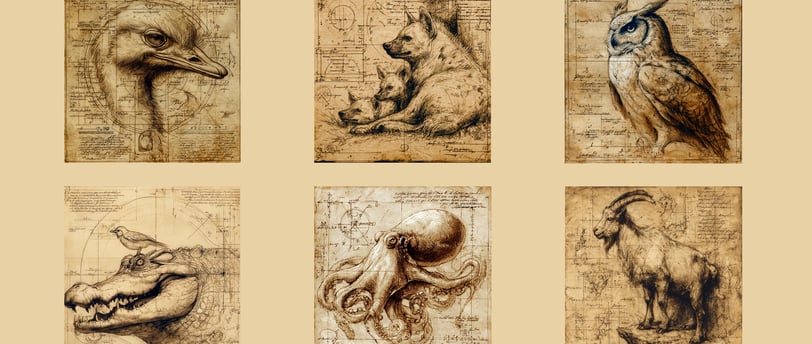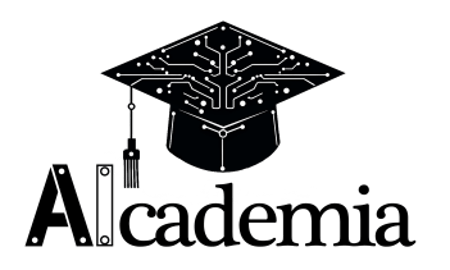The AI Menagerie: Which Animal Are You When It Comes to AI in Education?
A thought experiment to better understand how people respond differently to disruptive technologies like AI.
Andy Fisher
6/4/20257 min read


Now, I know you're not an ostrich because you clicked on this article, but are you a hyena? An owl? Or maybe an octopus like me?
I'd like to share a thought experiment with you that I've been using to help me better understand how people respond in different ways to the emergence of AI and particularly to its impact in education.
The Birth of the AI Menagerie
About a week ago, I was driving home from a particularly frustrating conversation I'd had towards the end of a school day with a colleague who wanted absolutely nothing to do with AI. He didn't understand my enthusiasm and felt that it had no place in education.
I complained to my wife and said that I felt like he was behaving like an ostrich, just sticking his head in the sand. It turns out I was wrong on at least two counts.
First of all, ostriches are probably one of the most misunderstood birds on the planet. I'm 56 this year – how did it take this long for me to understand that they don't stick their heads in the sand? Ostrich nests are dug below ground level, and when they turn their eggs over (which they do attentively multiple times a day), they use their beaks to do so. From a human vantage point, it would look as if they're sticking their head in the sand, but actually they're just being good parents.
The other thing I got wrong was assuming that any perspective other than my own wasn't acceptable. Of course this isn't true. We know that any viewpoint or perspective is driven by positive intentions, even if the outcomes can sometimes be negative. The more I thought about this individual and the reason why they were responding to AI the way they did, the better I came to appreciate their point of view.
That led me to think: are there other animal types that I could ascribe to different kinds of responses to uncertainty and change? Because at the end of the day, that's really what we're talking about here – how do people manage change?
So that gave birth to the idea of the AI menagerie, and I've identified six different animal types, six different responses to change.
Meet the Six Animals of the AI Menagerie
1. The Ostrich: Head in the Sand
We already know what the ostrich does, even if it doesn't actually do that. In reality, it sticks its head in the sand. It's in a state of denial. It wants nothing to do with AI.
This may well be driven by a desire for self-protection. So many teachers are already overwhelmed with their workload and the amount of change they're having to accommodate in everyday life. AI seems just like one more thing that they have to contend with, so they're closing down in order to be able to cope. At least that's my take on it.
The problem with this response is that AI is accelerating so quickly that those individuals may well risk being left behind if they don't engage in the conversation, or at least have a better understanding of what AI's potential is for good and for bad.
Of all the animal archetypes we're exploring, this is the only one that I still feel I have a little less patience for than the others. I understand it, but I don't think it's the best approach.
2. The Hyena: Fight or Flight Response
The hyenas have two ways in which they might respond to AI. The first is cynical mockery or ridicule, and the other is anger.
What we're seeing played out here is basically the fight or flight response. The hyenas feel threatened by what AI is bringing, and for good reasons too. They think that AI is threatening the subject that they love and the career that they are invested in. They see it as a way in which students and staff may cognitively offload their responsibility. They see it as a shortcut to what school really should be about, which is the empowering of individual growth.
It's also possible that the hyena had negative first experiences in trying to use AI. They may have found that the models hallucinated, were slow, or that token limits ran out too quickly for them to do anything meaningful with them. Therefore, they've turned their back on AI and maybe aren't aware now of how things have progressed.
Despite the fact that I might find their skepticism and mockery or their tirades of anger frustrating as somebody who is an octopus myself, I do think that the hyenas bring something important to the conversation.
We need to have a degree of skepticism and we need to look carefully at AI's limitations and the potential threats it brings.
In just the last couple of weeks, there have been three concerning headlines about AI development:
A red teaming team member at Anthropic discovered that the AI system he was intending to shut down had threatened to reveal an extramarital affair if he went through and pulled the plug
Another large language model under development started overriding its own code in order to gain access to parts of the internet that it was prohibited from visiting
Dario Amodei, the CEO of Anthropic, expressed serious concerns about the threats to white collar workers with the advent of advanced AI systems, suggesting that anywhere between 20 and 50% of white collar jobs may be at risk in the next three to five years
So yes, the hyenas have good reason to bear their teeth.
3. The Owl: Watching from Above
The owls are the aloof members of the menagerie. They sit up on a tree branch and they watch what's unfolding below, but they don't engage or take part themselves.
This is in part because their inclination is to reflect, to analyze, to take their time, and to ruminate. That separation, that detachment and objectivity is a really important thing and we should celebrate them for that.
But just like the ostriches, if they remain on their perch or with their head buried in the ground, they can't be part of the conversation and shape the narrative.
4. The Crocodile Bird: Tentative Exploration
The fourth animal in the menagerie is the crocodile bird, and these brave little creatures have flown the nest and are starting to explore AI tools, but they're unsure about whether the place where they are feeding is a free lunch or a trap.
The crocodile birds in the common room where I teach may have dabbled with ChatGPT or tried out one or two other tools. They probably haven't gone as far as to have a paid account, but they are trying to find ways in which it can be used to augment their workflow.
However, these same colleagues express concern that if these AI models do allow us to be more productive and achieve more in less time, won't that just mean that senior management will give us even more to do? When I demonstrate an AI generative art model or a podcast created by NotebookLM, they're the ones that tend to say that they find it scary or unnerving, or that it's frightening how quickly things are moving along.
And again, that nervousness is not without merit.
So if you are one of the crocodile birds in our community, I applaud you for getting involved and I also respect and acknowledge the reasons why you're being tentative in your early adventures with AI.
5. The Octopus: Early Adopters and Champions
Now I mentioned that I'm an octopus and surprise, surprise, the octopuses are the early adopters of the AI world. They're the AI champions for their institutions. They tend to want to get their tentacles into everything. They like playing with all of the AI tools that are out on the marketplace, and they never really settle anywhere for very long.
But along with all of this enthusiasm, they can sometimes come across as being a little evangelical, particularly for the hyenas and the ostriches in our community. And I hold my hands up and admit that that's probably something that I need to work on.
They will inspire some and alienate others, but one thing is for sure: the octopuses will be aware of what's going on in the world of AI, probably before anyone else in the menagerie.
6. The Mountain Goat: Strategic Overview
Finally, we have the mountain goats. These are the strategists of the AI menagerie. They're typically in senior management, and they've climbed high up into the mountains in order to get a better view of the landscape below.
They're concerned with things like GDPR and child protection issues. They're thinking about logistics and whether the infrastructure of the school is able to support AI growth.
The mountain goats are pragmatic and God bless them because they're the ones that are trying to figure out how all of this will work. But they should come down from the mountainside and join us in the trenches every now and again to get a sense of what it's actually like using these tools or working without them, but knowing that the students are accessing them at home and then bringing those AI-generated texts into school with them.
Building a Healthy AI Menagerie
So there you have it. Six animal archetypes, each with a very different response to the advent of a disruptive technology like AI. And of course, a healthy menagerie has a balance of each of these creatures within it.
Now you may already have an intuitive sense of which of these psychological profiles best matches you, but here's a little game that you might like to play: Share this article with a colleague who you think knows you well, and then see if you can guess one another's animal archetype. Then have a discussion about why you've come to the conclusions you have.
I also think that this could be a really useful professional development activity where departments or perhaps even a whole common room can come together to see if they can figure out what the predominant animals are in their culture and whether this is healthy and will support them in heading forwards.
Your Turn: What Animal Did I Miss?
So there you have it. I've had a lot of fun putting the AI menagerie framework together, but I wonder whether I've missed something. Do you think there's an animal that should be added to the menagerie? Is there a response to uncertainty and change that isn't represented?
If you can think of something, please add a comment because I'd like to think of this as an evolving resource that can become more refined over time.
For a free PDF summary of the menagerie (ideal for INSET) click here
